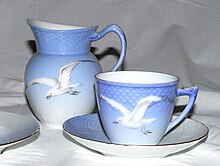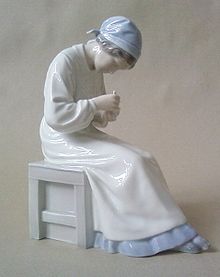Bing & Grøndahl porcelain factory
Bing & Grøndahl was a Danish porcelain manufacturer founded in 1853 by Frederik Vilhelm Grøndahl and the brothers Meyer Hermann Bing and Jacob Herman Bing in Vesterbograde, just outside Copenhagen . The porcelain mark (signature) for B&G shows three towers based on the coat of arms of Copenhagen. The company's best-known tableware was the Seagull range , which in the 1950s was standard in around ten percent of all Danish households. It is considered the Danish National Service . In 1987 the company merged with its largest competitor, the Danish Royal Porcelain Manufactory, and found itself under the common new name Royal Copenhagen . Even today, B&G porcelain is not only in demand among collectors.
First years
Grøndahl, a recognized figure designer at the leading Royal Danish porcelain manufacturer, teamed up in 1853 with the Bing merchants, who were trading in books and works of art, in order to set up their own porcelain factory on the outskirts of Copenhagen. Grøndahl first began to model classical figures based on the model of the sculptor Bertel Thorvaldsen . He mainly worked with bisque , unglazed hard-paste porcelain. It was relatively easy to work with and resembled marble or ivory . The small works of art were well received and with the financial success the company was able to expand.
Artists and Products
The manufacture of household goods followed. In 1892, Fanny Garde (1855–1925) designed the product line that was to bring the young company's greatest success: the modest-looking, pale blue and white crockery with the flying seagull and the handles made of partly fluted porcelain, which are reminiscent of seahorses . A cobalt blue and white service with a butterfly ( Sommerfugl ) continued the success.
In 1895 Bing & Grøndahl created the first Christmas plate in cobalt blue and white. That was also popular with customers. For more than 100 years, such a plate with traditional winter scenes came out every year. The plates were produced in limited editions and only in one year, at the end of the year the molds were destroyed to ensure the number of editions. Mother's Day plates were also quite popular. Plates have long made up a large part of B&G's production. You can still find many imitators today.
From 1868 on, the porcelain painter Heinrich Hansen officiated for a time as the artistic director of B&G. He mainly created portraits of Danish castles in their landscapes on porcelain.
The Danish sculptor Jens Peter Dahl-Jensen was model master at B&G from 1897 to 1917 . He became known to the general public primarily for his animal figures with underglaze painting. With the small sculpture porcelain designer , he set a monument to the profession.
The designer Henning Koppel created a few ceramics for B & G. He was best known here for his simple porcelain service Form 24 .
The multiple award-winning ceramist Gertrud Vasegaard earned fame above all for her tea service made of unglazed brown porcelain. The Danish Ministry of Culture included it in the list of the most important works of Danish culture as a masterpiece of Danish design .
See also
literature
- Poul Engelstoft: Porcelænsfabrikken Bing & Grøndahl 1853–1928. Copenhagen 1928.
- Minardi and Robin Hecht: Scandinavian Art Pottery: Denmark and Sweden. 2nd Edition. Schiffer Publishing, 2005, ISBN 0-7643-2239-7 , pp. 36-46.
- Pat Owen: Story of Bing and Grondahl Christmas Plates. Viking Import House, 1985, ISBN 0-911576-02-9 .
- Pat Owen: Bing and Grondahl Christmas Plates: The First Hundred Years. Landfall Press, 1995, ISBN 0-913428-76-0 .
- Carolin and Nick Pope: Bing & Grondahl figurines. Schiffer, 2002.
- Robert Leslie Smyth, RS Weightman: The International Ceramic Tableware Industry. Taylor & Francis Publisher, 1984, ISBN 0-7099-2352-X .
- Erik Zahle: Bing and Grondahl, 1853–1953. Danish Museum of Decorative Art, 1953.
Web links
Footnotes
- ^ Philo Lexicon. Handbook of Jewish Knowledge. 3. Edition. Berlin 1936, column 97.
- ↑ Leo Swane : Dahl-Jensen, Jens . In: Ulrich Thieme (Hrsg.): General Lexicon of Fine Artists from Antiquity to the Present . Founded by Ulrich Thieme and Felix Becker . tape 8 : Coutan-Delattre . EA Seemann, Leipzig 1912, p. 275 ( Textarchiv - Internet Archive ).
- ↑ Dahl-Jensen, Jens . In: Hans Vollmer (Hrsg.): General Lexicon of Fine Artists of the XX. Century. tape 1 : A-D . EA Seemann, Leipzig 1953, p. 509 .



